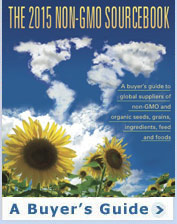“GM alfalfa will be everywhere”
By Ken Roseboro
Experts see major weaknesses in USDA review of GM alfalfa
A major battle over Roundup Ready (RR) genetically modified alfalfa has emerged because it represents a huge contamination threat to organic and conventional agriculture, and opponents don’t believe USDA’s proposed plan to allow it to be grown with restrictions will work.
“More problematic”
Alfalfa is grown on 22 million acres in the US, making it the fourth major crop after corn, soybeans, and cotton.
Organic farmers use alfalfa extensively. “Alfalfa is a feed staple for all organic livestock, and the most common legume in organic crop rotations in northern states,” says Jim Riddle, organic outreach coordinator at the University of Minnesota.
GM alfalfa is a huge threat because it is pollinated by bees and other insects that travel great distances and grows wild near roads, ditches, and yards. “You don’t have that with corn, soybeans, or cotton,” says Bill Freese, senior policy analyst at the Center for Food Safety. “Those things make it more problematic.”
According to a paper by Geertson Seed Farms, one of the biggest potential problems is that GM alfalfa will cross pollinate with wild alfalfa, which will become the dominant weed variety because it has the Roundup Ready herbicide tolerant trait. Weedy GM alfalfa will in turn become a source of pollen and seed that will contaminate conventional and organic alfalfa fields.
“GM alfalfa will be everywhere,” says Dag Falck, organic program manager at Nature’s Path Foods.
5-mile buffer
USDA’s Environment Impact Statement proposes an option whereby RR alfalfa would be grown with restrictions. The EIS lists production states according to three tiers. In 27 Tier 1 states, which include most eastern and southern states where no commercial alfalfa is grown, there would be no restrictions on RR plantings. RR alfalfa seed production would be limited in 14 Tier II and nine Tier III states where farmers must maintain isolation distances of five miles between GM and non-GMO alfalfa. Tier II states, such as Iowa, Kansas, and Missouri, are primarily in the Midwest and Tier III states, such as Arizona, California, Oregon, and Wyoming, are in the West.
EIS ignores roundup weed resistance, impacts on honey
Several experts see major weaknesses in the EIS. Freese says it doesn’t address the problem of weed resistance to Roundup herbicide, which is growing exponentially across the United States. Some 11 million acres of farmland contained Roundup resistant weeds in 2010. “Weed resistance is becoming huge issue,” he says.
In addition, conventional farmers have been using Roundup to remove old alfalfa plants. With RR alfalfa, they will have to use stronger, more environmentally harmful herbicides. This also wasn’t mentioned in the EIS.
“APHIS (USDA’s Animal and Plant Health Inspection Service, which wrote the EIS) doesn’t even acknowledge that RR crops are fostering weed resistance,” Freese says. “The whole EIS is filled with biases (toward approving RR alfalfa).”
Freese and others question the need for RR alfalfa. “Only 7% of alfalfa is treated with herbicides. It grows so densely that it crowds out weeds.”
Approving RR alfalfa, he says, will make it a “chemical dependent crop.”
The EIS also ignores the impact on honey, and the fact that bees will gather nectar from GM alfalfa plants and convert into honey. “This is another entry point for GMOs (into foods),” says Riddle.
(Copyright The Organic & Non-GMO Report, February 2011)




